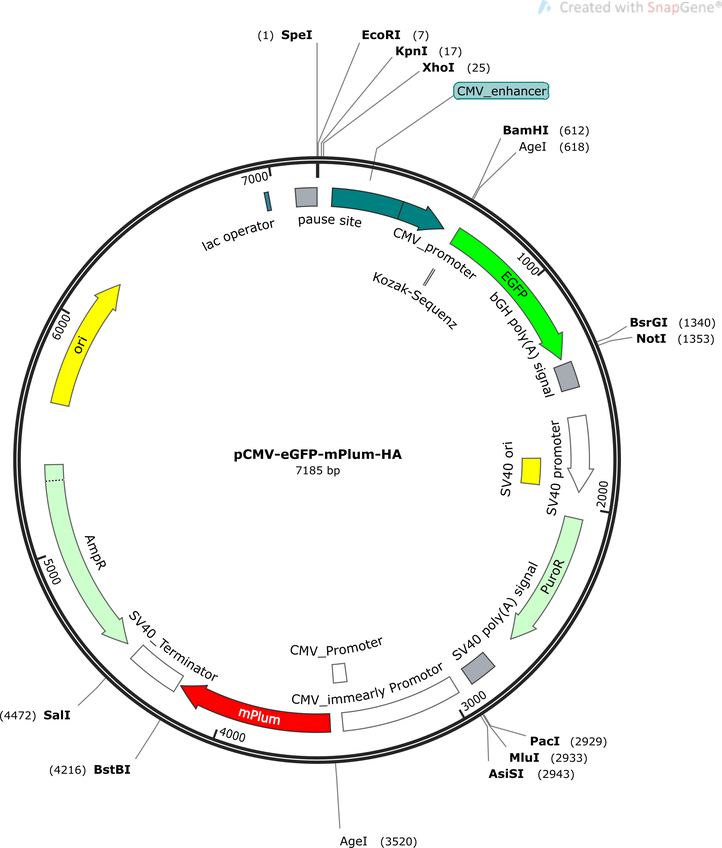pCMV-eGFP-mPlum-HA
(Plasmid
#200009)
-
PurposeDonor vector with double fluorescence system for targeted integration using CRISPR/Cas9. Expresses 5´HA--eGFP&PuroR--3´HA--mPlum. Distinguish targeted from random integration by fluorescence.
-
Depositing Lab
-
Sequence Information
Ordering
| Item | Catalog # | Description | Quantity | Price (USD) | |
|---|---|---|---|---|---|
| Plasmid | 200009 | Standard format: Plasmid sent in bacteria as agar stab | 1 | $85 | |
Backbone
-
Vector backbonepCMV-Green Renilla Luc
-
Backbone manufacturerThermo Fisher Scientific
- Backbone size w/o insert (bp) 5000
- Total vector size (bp) 7185
-
Vector typeMammalian Expression, CRISPR
-
Selectable markersPuromycin
Growth in Bacteria
-
Bacterial Resistance(s)Ampicillin, 100 μg/mL
-
Growth Temperature37°C
-
Growth Strain(s)DH5alpha
-
Copy numberHigh Copy
Gene/Insert
-
Gene/Insert nameeGFP, mPlum
- Promoter CMV
Cloning Information
- Cloning method Restriction Enzyme
- 5′ cloning site BamHI (not destroyed)
- 3′ cloning site SalI (not destroyed)
- 5′ sequencing primer Pause_for CTAGCAAAATAGGCTGTCCC
- 3′ sequencing primer AmpR_rev GGTGCCTCACTGATTAAGCATTGGT (Common Sequencing Primers)
Resource Information
-
Supplemental Documents
Terms and Licenses
-
Academic/Nonprofit Terms
-
Industry Terms
- Not Available to Industry
Trademarks:
- Zeocin® is an InvivoGen trademark.
These plasmids were created by your colleagues. Please acknowledge the Principal Investigator, cite the article in which the plasmids were described, and include Addgene in the Materials and Methods of your future publications.
-
For your Materials & Methods section:
pCMV-eGFP-mPlum-HA was a gift from Thomas Noll (Addgene plasmid # 200009 ; http://n2t.net/addgene:200009 ; RRID:Addgene_200009) -
For your References section:
Enhancing stability of recombinant CHO cells by CRISPR/Cas9-mediated site-specific integration into regions with distinct histone modifications. Hertel O, Neuss A, Busche T, Brandt D, Kalinowski J, Bahnemann J, Noll T. Front Bioeng Biotechnol. 2022 Oct 13;10:1010719. doi: 10.3389/fbioe.2022.1010719. eCollection 2022. 10.3389/fbioe.2022.1010719 PubMed 36312557





